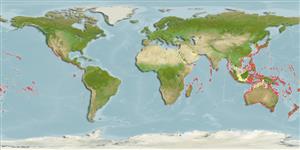Actinopterygii
辐鳍鱼纲 (条鳍鱼) >
Gonorynchiformes (Milkfish) >
Chanidae (Milkfish)
Etymology: Chanos: Greek, chanos, -eos, ous, and chasma, -atos = abyss, mouth opened, inmensity (Ref. 45335).
环境 / 气候 / 范围
生态学
; 海洋; 淡水; 半咸淡水 底中水层性; 非产卵性溯降河的 (Ref. 51243); 深度上下限 1 - 30 m (Ref. 6898), usually ? - 15 m (Ref. 89972). 15°C - 43°C (Ref. 43081), preferred 26°C (Ref. 107945); 46°N - 52°S, 19°E - 77°W
Indo-Pacific: along continental shelves and around islands, where temperatures are greater than 20°C. Red Sea and South Africa to Hawaii and the Marquesas, north to Japan, south to Victoria, Australia. Eastern Pacific: San Pedro, California to the Galapagos.
Length at first maturity / 大小 / 重量 / 年龄
Maturity: Lm 91.8, range 68 - 70 cm
Max length : 180 cm SL 雄鱼/尚未辨别雌雄; (Ref. 9710); 124.0 cm SL (female); common length : 100.0 cm SL 雄鱼/尚未辨别雌雄; (Ref. 9814); 最大体重: 14.0 kg (Ref. 9814); 最大年龄: 15 年 (Ref. 9814)
背棘 (总数): 2; 背的软条 (总数): 13-17; 臀棘 2; 臀鳍软条: 8 - 10; 脊椎骨: 46. This species is characterized by the following: body elongate and somewhat compressed; mouth small and toothless; branchiostegal rays 4; one dorsal fin; pectoral fins falcate; body olive green; flanks silvery; fins dark bordered (Ref. 55763). Superficially resembles bonefishes but by evolution more advanced by having 4 branchiostegal rays (Ref. 1602); jaws toothless (Ref. 12693); with 31 caudal fin rays (Ref. 50686).
Found in offshore marine waters and shallow coastal embayments, but also frequently enter estuaries and occasionally penetrate freshwater streams (Ref. 44894). A marine species which enters estuaries and rivers (Ref. 52331). Adults occur in small to large schools near the coasts or around islands where reefs are well developed. Eggs and larvae are pelagic up to 2-3 weeks. Older larvae migrate onshore and settle in coastal wetlands (mangroves, estuaries) during the juvenile stage, or occasionally enter freshwater lakes. Juveniles and sub-adults return to sea where they mature sexually. Spawn only in fully saline water. Larvae eat zooplankton; juveniles and adults eat cyanobacteria, soft algae, small benthic invertebrates, and even pelagic fish eggs and larvae. Larvae are collected from rivers and are grown in culture ponds into juveniles, which are marketed fresh, smoked, canned or frozen. Brood stocks can be raised and spawned in captivity to produce larvae in the hatchery (Ref. 12868). Can thrive and grow in water as hot as 32° C (Ref. 9987).
Life cycle and mating behavior
成熟度 | 繁殖 | 产卵场 | 卵 | 孕卵数 | 仔鱼
Spawns in clear shallow waters above a bottom of sand or coral and at a distance of not more than 30 km from the shore. Females spawn up to 5 million eggs which hatch in about 24 hr. The larvae seek out clear coastal and estuarine waters warmer than 23°C with 10-32 salinity and abundant phytoplankton. Spawning and fertilization take place at night.
Bagarinao, T., 1994. Systematics, distribution, genetics and life history of milkfish, Chanos chanos. Environ. Biol. Fish. 39(1):23-41. (Ref. 9814)
CITES (Ref. 94142)
Not Evaluated
人类利用
渔业: 高经济性; 养殖: 商业性; 游钓鱼种: 是的; 诱饵: usually
工具
特别资料
下载 XML
网络资源
